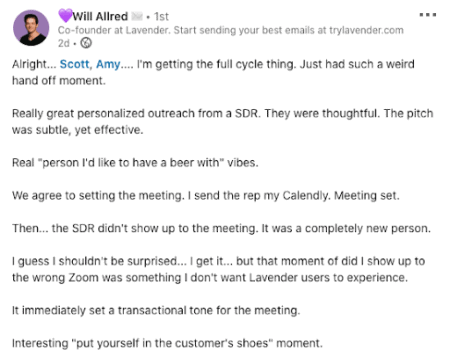
Is SaaS Sales Over Segmented?
Back in the dark ages (when dinosaurs roamed the Earth), I grew up in the enterprise sales world of having to do everything myself:
- Researching my market
- Prospecting my target buyers
- Discovery calls
- Strategy
- Sales meetings
- Closing
- Account management
- Client success
And while I understand why so many celebrate the ways found to make the sales process more ‘efficient’ through segmentation, we’ve gone too far.
Think I’m wrong? Start talking to your buyers.
Case in point complements of Will Allred via LinkedIn this week:

He’s not alone, I’ve had countless experiences (as a buyer) where I feel like I have to jump through hoops just to get the information I want to make a purchase.
And I have to tell you, I detest it.
Why the segmented SDR model doesn’t work at scale
The basic idea beyond the SDR/AE model is simple: segment the sales process into distinct parts, train employees for specific parts of the process, and improve efficiency across the board.
Sounds great in theory, but it’s a different story in practice.
The glaring problem is that its unnatural to your buyers.
Think about it, if you were in the complicated process of buying your first home and you really connected with the first agent you spoke to, how would you feel if they suddenly handed you off to someone else halfway through?
For me, it’d make me question the validity of the relationship and make me feel like just another row on their transaction list. I’d be skeptical of moving forward with the deal because that first agent will have breached my trust, along with being annoyed that I’d probably have to go through all of my ‘must haves’ and ‘whys’ yet again.
Another downside of the SDR model is that there are a TON of hidden costs associated with it.
Remember: you have to pay your SDRs, the team leader, all the tools/software they need to succeed, etc. Layer in the fact that the average sales rep leaves within 1.5 years (and it takes 3.2 months on average to onboard a new SDR) –– along with an average turnover rate of an SDR at 34% (Bridge Group data) with nearly two-thirds of that number being voluntary –– and you’re pumping money down the drain.
The truth is that there’s a huge gap between expectations and reality when you’re building your business around a ‘growth at all costs’ mindset. You think you’re building an efficient and seamless sales process, but you’re actually doing the opposite that leaves your buyers with a lackluster experience and icky feeling.
Nobody wants to be handed off.
A buyer wants to understand how you can help them while feeling heard, not get funneled through a process that forces them where you want them to be.
To succeed, you need to seek to understand your buyers’ needs, build meaningful relationships with them, and show them exactly how you’ll help them get there.
Remember: sales is all about people.
“Personally I am very fond of strawberries and cream, but I have found that for some strange reason, fish prefer worms. So when I went fishing, I didn’t think about what I wanted. I thought about what they wanted. I didn’t bait the hook with strawberries and cream. Rather, I dangled a worm or grasshopper in front of the fish and said: “Wouldn’t you like to have that?”
Why not use the same common sense when fishing for people?” –– Dale Carnegie
If there’s one thing you need to remember when developing your sales process, it’s to focus on the fact that you’re dealing with people –– i.e. your buyers.
There’s nothing more important for sales than to build relationships with your buyers over time.
That’s why segmentation is the bane of sales –– it makes it much more difficult for a buyer to connect with your brand.
The other day, I got on a call with an SDR who was lovely (in fact, I didn’t even know he was an SDR).
After a great conversation with him, I asked if I could see the technology.
His response?
“Sorry, we’ll have to set up a meeting with an AE for that.”
I sighed and agreed. But when I got on a call with the AE, the first thing they said to me was, “So, why are we talking today?”
Really? Do I have to have the same conversation a second time? Did you not communicate with your SDR behind the scenes?
Situations like these (which have become all-too-common) are turning buyers off from purchasing.
Case in point –– after this unbelievably painful demo, which touched on none of the points I had discussed with the SDR previously, I immediately began researching their competitors.
And while I’m at it, even if the buyer still buys in the end, your segmented sales process is undoubtedly going to stop them from having a positive relationship with your brand.
So when your next product iteration comes out, they might not be so interested in upgrading. The lack of buyer relationship = a significant loss of revenue down the line.
An example of a company that’s doing it right is Shopify Plus.
They recognized that nobody wants to be “handed off” during the sales process, so they’ve built a system that doesn’t do it.
Shopify Plus doesn’t have SDR’s or AE’s. Instead, they only have one point of contact with each buyer, who they’ve called a Sales Hacker.
“The Results? We’ve found that giving prospects a single person to handle the entire process has created faster sales cycles, allowing our reps to complete more deals per month while increasing customer satisfaction. Our sales cycles range from two hours to two months in length with an ASP north of $10,000, proving you can sell good-sized deals very quickly with the right approach. One Rep, One Call, that is what customers want.” –– Loren Padelford, GM at Shopify Plus
I don’t know about you, but I’d much rather communicate with one Shopify Sales Hacker that I trust than get funneled through a disjointed process.
Focus on your buyers, reap the rewards.
Personally, I think it’s time to kiss the over segmentation of sales goodbye and start enabling anyone in a customer facing role to have a real conversation to meet buyers where they are, versus where we’re trying to force them to be.
Instead, turn your focus on your buyers to understand how you can help them solve problems, reach goals, or get better. That’s the surefire way to succeed at a time when more and more companies are segmenting their sales processes.
As we wrap things up, here are a few strategies to keep in mind when you’re building out your sales process.
- Stop assuming and listen to your buyers.
This is crucial! Celebrate discovery and rediscovery to figure out what they respond well to and work your ‘process’ around their needs. The more you get to know your buyers, the more well-equipped you’ll be to serve them. - Invest in demand generation.
Support your sales team with a stream of high-quality leads and they’ll have what they need to hit the ground running. - Invest in your salespeople
“Take care of your employees and they will take care of your business. As simple as that.” – Sir Richard Branson
He’s absolutely right and the faster you realize what proper onboarding, training and continuing support can do, the stronger your business will be. Let’s be honest, the right training can work wonders –– especially when we’re talking about entry-level SDR’s. If you want your sales team to succeed, they need to be well-versed and comfortable with having conversations with buyers at all stages of the sales cycle. - More them, less you
No matter what, you need to put your buyers first. They hold the keys to your success… without them there is no business.So instead of focusing on how to improve efficiency within your sales process, focus on the needs of your buyers and how you can give them exactly what they want.
My formula for success has never failed me and bears repeating here: the right work + the right people + consistency = success for the long haul.
